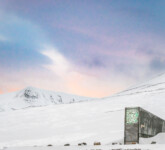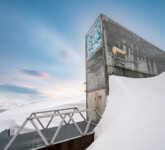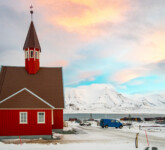For years, I have been seeing photographs of the Svalbard Global Seed Vault. And in nearly every photograph, the snow is blue. The Svalbard Archipelago is halfway between the Arctic Circle and the North Pole, so I often wondered if perhaps up there the snow truly is blue.
I finally got an opportunity to travel to Svalbard last month. And I can ensure you … the Arctic snow is perfectly white. It’s just that our not-so-smartphones think it’s blue.
I bought my first camera – an Olympus OM-1 – in 1978 and taught myself how to be a photographer while tromping through the north woods of Wisconsin in winter. I was disappointed when my first Kodachromes came back. The snow was grey and underexposed.
The OM-1 had a built-in light meter but a camera’s reflective light meter measures light bouncing off a subject and it is calibrated to render everything at an 18% neutral grey tone. So if you’ve got a predominantly white scene the camera’s meter will underexpose it.
I learned to overexpose snow scenes and later started using an incident light meter which measures the light striking an image. I no longer had underexposed Kodachromes.
But the blues of winter kept creeping into my snowy shots. My eyes didn’t see that blue, but my Kodachromes showed them. Snow is made up of countless tiny ice crystals, which scatter light in all directions. Since blue light scatters more, it is more likely to reach the camera film. The human eye has an automatic white balance which compensates for that blue light and renders snow white. So in those days I’d carry a warming filter to get snow to look like snow.
Nowadays, we seem to leave all the brains to our cameras. As soon as I hit the tarmac in Longyearbyen, I whipped out my Samsung Galaxy to see how ‘smart’ it was. It wasn’t. That characteristic cold blue of Svalbard was on my phone screen. I looked at the snowy mountains and saw warm late afternoon colours against brilliant white snow. I relegated the smartphone to my pocket for the rest of my 44-hour visit and stuck to my trusty Nikon.
I didn’t have the luxury of time to be fussing about with overexposing and warming filters. I had something even better than Kodachromes … RAW digital images. If you shoot in RAW the camera captures a ton of information … millions of pixels of information … about the scene. You just have to adjust it on your computer. By shooting RAW and using Adobe Lightroom, I have been able to re-create what my eyes were seeing in the Arctic and not what my camera thinks I was seeing.
For the first 43 hours of my visit, my eyes only saw a monochromatic landscape as it was cloudy and windy. But as we were driving to the airport my Crop Trust mate, Benjamin Kilian, and I decided to swing past the Seed Vault for a final goodbye. I ran up the slippery snow-covered hill behind the Seed Vault and started screaming. Surely Ben thought I was being devoured by a polar bear. In fact, I was screaming with elation as I was witnessing a brilliant sunrise come up over the mountains of Spitzbergen and I was there to finally show that you can indeed capture a full palette of colours in the Arctic.





